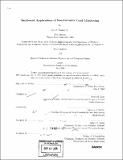Shipboard applications of non-intrusive load monitoring
Author(s)
Ramsey, Jack S
DownloadFull printable version (12.72Mb)
Other Contributors
Massachusetts Institute of Technology. Dept. of Electrical Engineering and Computer Science.
Advisor
Steven B. Leeb.
Terms of use
Metadata
Show full item recordAbstract
The Non-Intrusive Load Monitor (NILM) provides a method of measuring component performance and source power quality through a single point of entry in the power distribution system. A study was performed utilizing the NILM onboard three different ships (along with experimentation in the laboratory) to determine its effectiveness in determining the state of mechanical systems through analysis of electrical power data. Data collected from the Auxiliary Seawater System onboard the USCGC SENECA indicate that the NILM is able to predict several faults (clogged pump inlet strainers, faulty motor/pump coupling, fouled heat exchangers) as well as provide a backup indication of flow levels to heat loads. Data collected from the Sewage System of the SENECA indicate several metrics which can be applied to cycling systems in general to differentiate between periods of heavy usage and fault conditions. Finally, data collected from the Steering System of the SENECA as well as a yard patrol boat operated by the Office of Naval Research shows the potential of the NILM to be used as a control system without the need for separate mechanical transducers.
Description
Thesis (Nav. E.)--Massachusetts Institute of Technology, Dept. of Ocean Engineering; and, (S.M.)--Massachusetts Institute of Technology, Dept. of Electrical Engineering and Computer Science, 2004. Includes bibliographical references (p. 89-90).
Date issued
2004Department
Massachusetts Institute of Technology. Department of Electrical Engineering and Computer Science; Massachusetts Institute of Technology. Department of Ocean EngineeringPublisher
Massachusetts Institute of Technology
Keywords
Ocean Engineering., Electrical Engineering and Computer Science.